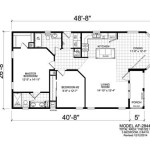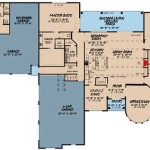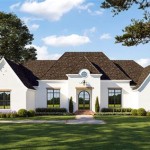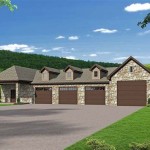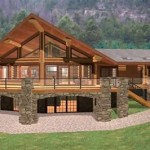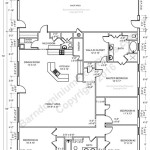```html
Floor Plans For Vacation Homes
The selection of an appropriate floor plan is a critical element in the successful design and construction of a vacation home. Unlike primary residences, vacation homes often serve a different purpose and are subject to distinct usage patterns. Designing for flexibility, comfort, and the specific needs of the intended occupants is paramount. The ideal floor plan effectively balances communal living areas with private retreats, maximizes natural light and views, and considers the potential for rental income and future resale value.
The considerations for vacation home floor plans differ significantly from those for a permanent dwelling. Vacation homes may need to accommodate larger groups less frequently, requiring design choices that prioritize spaciousness and adaptable spaces over the everyday efficiency of a primary residence. Furthermore, the often-unique locations of vacation properties, such as beachfronts, mountainsides, or lakeside settings, necessitate floor plans that capitalize on the surrounding environment and offer seamless integration of indoor and outdoor living.
Key Considerations for Vacation Home Floor Plans
Several fundamental elements should be addressed when evaluating or developing floor plans for vacation homes. These considerations encompass spatial organization, adaptability, and the integration of the natural environment.
1. Number of Bedrooms and Bathrooms: Determining the optimal number of bedrooms and bathrooms is crucial. This decision should be driven by the anticipated occupancy rate, the probable size of visiting groups, and the potential for rental income. A vacation home intended to accommodate multiple families simultaneously will require a greater number of bedrooms, often with en-suite bathrooms, to ensure privacy and comfort. Bunk rooms can be a practical solution for accommodating children or larger groups of friends. The placement of these bedrooms relative to living areas is also critical, with attention paid to minimizing noise transfer.
The floor plan should also consider the placement and accessibility of bathrooms. A powder room located near the main living area is beneficial for guests. Outdoor showers, especially in coastal locations, can enhance the vacation experience and reduce the amount of sand or dirt tracked indoors. Attention to bathroom layout and fixture selection is important to maximize space and functionality. Durability and ease of cleaning are also key considerations in selecting bathroom materials.
2. Open Concept Living Areas: Open-concept living areas, seamlessly integrating the kitchen, dining, and living spaces, are highly desirable in vacation homes. These arrangements promote social interaction and create a sense of spaciousness, ideal for gatherings of family and friends. The kitchen, often the heart of the vacation home, should be functional and well-equipped, with ample counter space and storage. A large island can serve as a focal point for meal preparation and casual dining. The dining area should comfortably accommodate the anticipated number of occupants, and the living area should provide comfortable seating and entertainment options.
The location of the living area relative to outdoor living spaces is important. Sliding glass doors or French doors can create a seamless transition between indoors and outdoors, extending the living space and maximizing enjoyment of the surrounding environment. Considerations should also be given to furniture selection, opting for durable, comfortable pieces that are easy to clean. Proper consideration should be given to the flow of traffic within the open concept space, ensuring easy movement between different areas.
3. Outdoor Living Spaces: A well-designed outdoor living space is an essential component of a successful vacation home floor plan. Decks, patios, and porches provide opportunities for relaxation, recreation, and enjoyment of the natural surroundings. The size and configuration of the outdoor living space should be determined by the intended use and the specific characteristics of the site. A covered porch can provide protection from the sun and rain, extending the usability of the outdoor space. Outdoor kitchens, fire pits, and comfortable seating areas can enhance the vacation experience.
The design of the outdoor living space should complement the architectural style of the vacation home and seamlessly integrate with the surrounding landscape. Careful consideration should be given to the selection of materials, choosing durable, weather-resistant options that require minimal maintenance. The orientation of the outdoor living space should be carefully considered to maximize sun exposure and views, while also providing adequate shade and privacy. Landscaping can be used to enhance the beauty and functionality of the outdoor living space.
Maximizing Space and Functionality
Effective space utilization and functional design are crucial for optimizing the usability and enjoyment of a vacation home. Incorporating flexible spaces, maximizing storage, and considering accessibility can significantly enhance the overall experience.
Flexible Spaces: Designing flexible spaces that can serve multiple purposes is particularly beneficial in vacation homes. For example, a bonus room can function as a home office, a game room, or an additional sleeping area. A sunroom can be used for relaxation, dining, or indoor gardening. The key is to design these spaces with adaptability in mind, incorporating features such as convertible furniture, modular shelving, and flexible lighting. The placement of these spaces relative to other areas of the home is also crucial, with consideration given to noise levels and privacy.
The use of convertible furniture, such as sleeper sofas, futons, and folding tables, can significantly increase the sleeping capacity and functionality of a vacation home. Modular shelving systems can be easily reconfigured to accommodate different storage needs. Flexible lighting options, such as dimmers and adjustable task lighting, can create different moods and serve different purposes. These flexible spaces can make the home more versatile and appealing to a wider range of potential renters or buyers.
Maximizing Storage: Adequate storage space is essential in a vacation home, particularly for seasonal items, recreational equipment, and guest belongings. Incorporating built-in storage solutions, such as closets, cabinets, and shelving, can help to maximize space and minimize clutter. Attics, basements, and garages can also provide valuable storage space. The key is to design storage areas that are easily accessible and well-organized.
Consider incorporating storage benches in mudrooms or entryways to provide a place to store shoes, coats, and other outdoor gear. Utilize wall space with shelving units and cabinets. Consider adding storage under beds. Maximize storage in the kitchen with pull-out drawers, pantry shelving, and overhead cabinets. A well-organized storage space can significantly improve the overall functionality and convenience of a vacation home.
Accessibility: Designing with accessibility in mind can make a vacation home more welcoming and inclusive for people of all ages and abilities. Consider incorporating features such as ramps, wide doorways, and grab bars in bathrooms. A single-story floor plan can eliminate the need for stairs altogether. The key is to create a home that is comfortable and accessible for everyone.
Consider incorporating universal design principles, which focus on creating spaces that are usable by people of all abilities. This includes features such as lever-style door handles, adjustable-height countertops, and roll-in showers. Even if accessibility is not a primary concern, incorporating these features can make the home more comfortable and convenient for everyone.
Integrating the Natural Environment
A vacation home's allure often stems from its proximity to natural beauty. The floor plan should seamlessly integrate the interior with the surrounding environment, maximizing views, natural light, and outdoor access.
Optimizing Views: Careful consideration should be given to the orientation of the vacation home on the site to maximize views of the surrounding landscape. Large windows, sliding glass doors, and balconies can frame stunning vistas and bring the outdoors in. The placement of rooms within the floor plan should also be strategically planned to take advantage of the best views. Living areas and bedrooms should ideally be located on the side of the home with the most desirable views.
Consider using window treatments that allow for maximum natural light while still providing privacy. Skylights can also be used to bring natural light into rooms that do not have direct access to windows. The use of mirrors can also help to reflect light and create a sense of spaciousness. The key is to create a home that is bright and airy, with stunning views of the surrounding environment.
Natural Light: Maximizing natural light is crucial for creating a bright and airy living space. Large windows, skylights, and strategically placed doors can flood the interior with natural light. The orientation of the home on the site should also be considered to maximize sun exposure. South-facing windows will provide the most sunlight throughout the year, while east-facing windows will capture the morning sun. Proper shading devices can help to prevent overheating during the summer months.
Consider using light-colored paint and finishes to reflect natural light and make the space feel brighter. Avoid using heavy window treatments that block natural light. Instead, opt for sheer curtains or blinds that allow light to filter through. Natural light can significantly improve the mood and health of occupants, making it an essential element of a vacation home floor plan.
Indoor-Outdoor Flow: Creating a seamless transition between indoor and outdoor living spaces is a key element of a successful vacation home floor plan. Large sliding glass doors, French doors, and covered porches can extend the living space and allow occupants to enjoy the natural surroundings. Outdoor kitchens, fire pits, and comfortable seating areas can further enhance the outdoor living experience.
Consider using similar materials and finishes both indoors and outdoors to create a sense of continuity. For example, use the same flooring material on the deck as in the living room. Plant landscaping that complements the architectural style of the home. The key is to create a seamless transition between indoors and outdoors, blurring the lines between the two spaces.
```
Four Season Vacation Home Plan 2177dr Architectural Designs House Plans

Rustic Vacation Homes Simple Small Cabin Plans Houseplans Blog Com

Vacation House Plans Home Design Ls H 8337 A Cottage Floor Small

Simple Vacation House Plans Small Cabin Lake Or Mountain

63 Vacation House Plans Ideas

4 Bedroom Floor Plan Ranch House By Max Fulbright Designs

Floor Plan Affordable Orlando Vacation Home House Layouts Layout Plans

Rustic Vacation Homes Simple Small Cabin Plans Houseplans Blog Com

Featured House Plan Bhg 7686

Vacation Floor Plans
See Also

